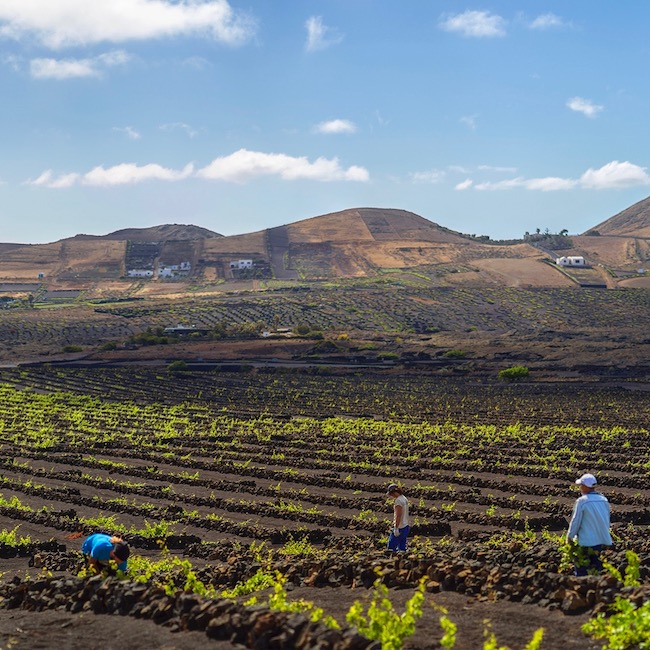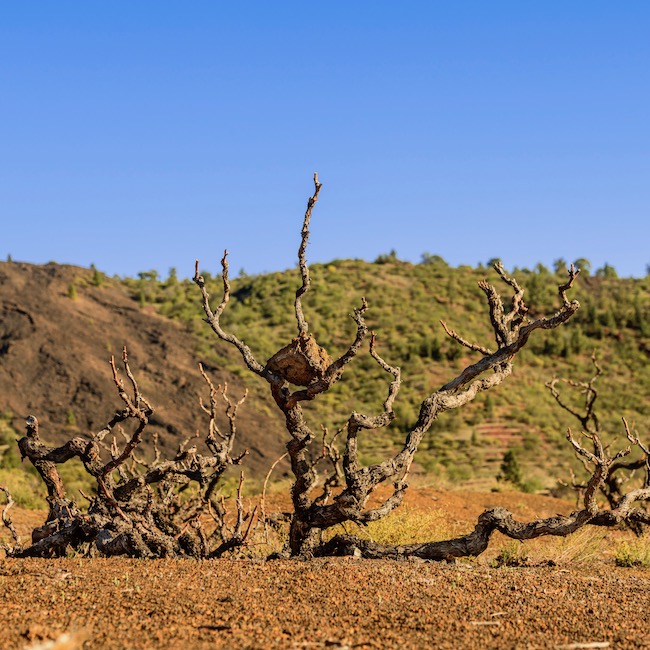.png.transform/rendition-xs/image_image%20(1).png)
The Canary Islands and their Iconic Grape Varieties: an Exciting World to Explore
Variety is the word when talking about the grapes of the Canary Islands. Isolated from the vine-destroying phylloxera louse, the traditional vineyards retain a plethora of ancient varieties.
Roberto Santana of Envínate makes a number of wines in Tenerife, including Tagnanan Negro from a blend that includes Vijariego Negro, Negramoll, Moscatel Negra, Listán Negro and Listán Gacho. He explains more about this diversity:
“Here we think that the area is more important than the variety. There are a few reasons for this. As phylloxera is not an issue in the Canary Islands, we don’t buy grafted vines from nurseries, we use our own genetic material, or clone from neighbours’ vines, which means that the vines are highly adapted to specific microclimates. The traditional vineyards tend to be planted with a mixture of varieties so we make local blends, simply separating red and white.”
Vidueño is the traditional name used locally to describe a field blend. Suertes del Marqués makes a version that includes Malvasía Rosada, Negramoll, Vijariejo Negro, Laboso Negro, Listán Negro, Tintilla, Castellana Negra, Albillo Criollo, Gual, Verdello…

The Listán varieties
Listán Blanco and Listán Negro are the most widely planted grapes, found across all islands and DOs, although with very different expressions. As Roberto Santana comments, they “are particularly good at moulding themselves to every different terroir.” Victoria Torres Pecis makes a 100% Listán Blanco on La Palma known as Las Machuqueras, with a captivating nose of honeysuckle and banana, and a lean palate. In other expressions, such as Flor de Chasna from DO Abona, more herbaceous notes of boxwood, mint and nettle stand out, whereas Cráter Blanco from Bodegas Buten in DO Tacoronte-Alentejo has a marked volcanic and slightly saline character.
Many producers, such as Los Bermejos in Lanzarote, are using carbonic maceration to produce explosively fruity reds from Listán Negro. Pagos de Reverón, located in Spain’s highest village, at 1,300 metres, uses the technique in their organic red made from 80% Listán Negro with 10% Castellana and 10% Tempranillo. Fresh and lively, it bursts with juicy blueberries and cherries.
Listán Prieto –known as Mission in California and País in Chile – is also attracting interest. Envínate makes a 95% Listán Prieto red wine (with 5% Tintilla) called Benje in DO Ycoden Daute Isora. An elegant, light-bodied red, it displays fragrant red berry aromas and the smoky minerals associated with volcanic soils.
Malvasía, an iconic grape
Introduced by the Portuguese at the end of the 15th century, Malvasía is the grape variety with the longest history of cultivation on the islands. Malvasía is an umbrella term for a number of different grapes. In the Canary Islands there are two main expressions, Malvasía Volcánica, found on Lanzarote, and Malvasía Aromática, found on Palma and Tenerife.
For Sara Eizaguirre, winemaker at Bodegas Stratvs on Lanzarote, Volcanic Malvasía is the island’s iconic variety. “It’s our flagship variety, which has earned the island fame. A very low yielding grape, it is well adapted to the growing techniques and the soil – lapilli or picón (volcanic ash). It is very aromatic, with good acidity and structure, which allows it to be barrel-aged, as is the case of our Stratvs Finca Las Palmeras. But it is also great for making fresh, dry wines such as our Stratvs Malvasia seco, as well as Stratvs semi-dulce.”
Also in Lanzarote, El Grifo, founded in 1775, makes everything from zippy, aromatic dry Malvasias to a reproduction of the historic Canary Sack wines from the 17th century. Called Malvasía Canari, it is made from partially dried grapes and fortified to create a naturally sweet wine that is then oxidatively aged.
In La Palma, Victoria Torres Pecis makes a sweet Malvasía from late harvested grapes made in a traditional open lagar of local Tea pine. Lusciously sweet but balanced, it shows highly concentrated flavours of orange blossom and spectacular length. Cumbres de Abona from DO Abona in Tenerife makes a similarly sweet style, which displays notes of orange oil, tealeaf and caramel.

The elegant and floral Negramoll
Known as a Tinta Negra Mole in Madeira, Negramoll can make very attractive Pinot Noir-like wines. Cráter Magma from Bodegas Buten in DO Tacoronte-Acentejo, is a blend of 90% Negramoll with 10% Syrah that displays beautiful floral aromas of violets and red berries, a dry spiciness and long, elegant palate.
Negramoll is also found on the island of La Palma, with Victoria Torres Pecís again making some excellent examples that are imported into the USA by David Bowler Wine.
Other grapes
A 2019 study identified an astounding 79 local cultivars in the Canary Islands, far too many to cover here, but in terms of quality, Ferran Centelles said in a report on jancisrobinson.com that his “preference was for the powerful, smoky and sometimes leathery Baboso Negro (known as Alfrocheiro in Portugal) and the mineral and chalky Vijariego Negro (Sumoll).”
Borja Pérez Viticultor makes monovarietal wines from both of these varieties in DO Ycoden-Daute-Isora, as does Viñátigo, a winery focused on reviving Tenerife’s extensive varietal heritage and producing a wide range of single varietals including Gual and Marmajuelo whites.
Hermanos Mesa also makes a single varietal Marmajuelo in DO Valle de Güímar that brims over with tropical fruit aromas and a hint of fennel, whereas Bodegas Drago’s Gual is spicy and rounded with peach and banana aromas.
Whichever varieties they are made from, wines from the Canary Islands have a thrilling energy and character all of their own that makes them well worth exploring.

